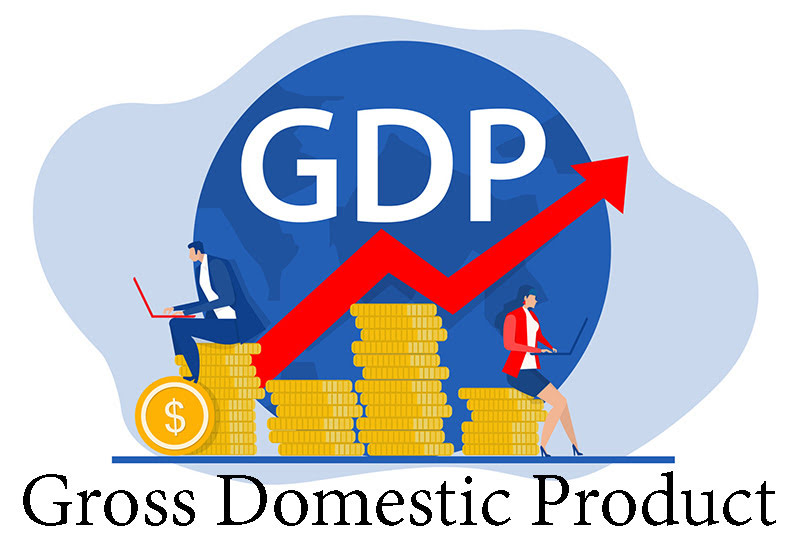GDP is a metric used to quantify economic activity that occurs inside a nation’s borders. It shows the overall value, usually quarterly or annually, of all goods and services produced during a given period of time. One important metric for assessing the state of a country’s economy is its GDP. While lower GDP levels may suggest financial difficulties, higher GDP figures generally imply a thriving economy with more production, jobs, and money.
Gross Domestic Product 2025
GDP calculates the total worth of all commodities and services generated in a nation, including books and cars, as well as labor-intensive jobs like teaching and cab driving. But not everything is included in GDP, including home chores and business dealings in the “black” economy, where no records are kept of transactions. We’ll examine the two forms of GDP: real GDP, which accounts for inflation, and nominal GDP, which does not. GDP per capita and adjusted GDP are useful tools for comparing the economic performance of various nations.
Economic Performance
Next, we’ll look at the three primary approaches used by economists to determine GDP: looking at overall expenditure, value added at every level of production, and revenue produced by individuals and companies. Lastly, we’ll talk about the effects of GDP expansion or contraction. While a declining GDP frequently denotes economic difficulties, such as job losses and lower corporate income, a growing GDP usually indicates more jobs, higher expenditure, and a thriving economy.
Check Here:-
What is GDP?
A key economic indicator, the gross domestic product (GDP) represents the total monetary value of all finished products and services produced in a nation over a given period of time. It is a measure of a country’s ability to create wealth and is sometimes shortened to GDP. This measure measures the total worth of all commodities and services generated in a nation, from tangible goods like cars, apples, and books to the many services rendered by experts like teachers, doctors, lawyers, and cab drivers.
Employment Opportunities & Attract Investments
Certain variables, including consumer spending and activity in the informal economy, are difficult to assess accurately and hence present a difficulty for inclusion in GDP calculations. However, GDP continues to be a crucial indicator of a nation’s economic health, impacting its capacity to create jobs and draw in foreign investment. The main indicator used to determine the size of an economy is its annual GDP, which is often calculated on a quarterly basis and represents all of the output of a nation in a given year.
Types of Gross Domestic Product
Let’s examine the different kinds of GDP:
- Nominal GDP: The Gross Domestic Product (GDP) expressed without accounting for inflation is known as nominal GDP. It shows the overall worth, at current prices, of the goods and services generated in an economy. Nominal GDP fluctuates in tandem with price fluctuations.
- Real GDP: Real GDP provides a more accurate indicator of a nation’s economic growth by taking inflation into account. In order to exclude the effects of inflation, it uses constant prices. Real GDP allows changes in economic output to be quantified in real terms. It is computed by converting nominal GDP statistics to base-year prices using a price index such as the Consumer Price Index (CPI).
- GDP per capita: A nation’s average level of life or the distribution of wealth among its citizens are evaluated by its GDP per capita. It is calculated as the GDP divided by the total population of a nation to get the economic production available to each citizen. GDP per capita, however, does not account for income differences, which could distort how wealth is distributed within a nation.
- PPP GDP: GDP by Purchasing Power Parity (PPP GDP) modifies the GDP of a region to take into consideration variations in international prices. PPP GDP offers a more realistic evaluation of the economy and the well-being of the populace by accounting for the purchasing power of the population. This modification improves cross-national comparisons’ fairness and realism.
Check Here:-
Implications of GDP Growth & Decline
An increase in GDP indicates a strong economy that benefits most of the people living in the nation. On the other hand, a decline warrants caution. Similar to a family’s or business’s revenue, a rise in GDP is usually indicative of economic health, whereas a fall indicates difficulties. A rise in GDP indicates increased investment, consumption, and general economic activity in the nation—all of which go toward calculating GDP. A decline in GDP or a recession reduces company profits and consumer spending, which in turn limits chances for investment and employment.
How is GDP calculated?
Now let’s explore the methodologies:
- Expenditure Method: Using this method, residents’ cumulative spending on completed goods and services is totaled and expressed as:
GDP=C+I+G+X−M\text{GDP} = C + I + G + X – MGDP=C+I+G+X−M
Where: CCC: Consumption III: Investment GGG: Government spending XXX: Exports MMM: Imports
- Value Added Method: Using this method, the gross value added produced in a nation during a given time period during the production of products and services is totaled and is represented as:
GDP=GVA+taxes−subsidies\text{GDP} = \text{GVA} + \text{taxes} – \text{subsidies}GDP=GVA+taxes−subsidies
Where: GVA\text{GVA}GVA: Gross value added
- Income Method: Using this method, the total income that owners of producing factors—labor and capital—earn over a specified time period is determined:
GDP=RA+EBE+taxes−subsidies\text{GDP} = \text{RA} + \text{EBE} + \text{taxes} – \text{subsidies}GDP=RA+EBE+taxes−subsidies
Where: RA\text{RA}RA: Remuneration of employees EBE\text{EBE}EBE: Gross operating surplus.
Check Here:-
Economic Implications of GPD
- Economic Growth: The main indicator of economic growth is the GDP. A growing economy is indicated by an expanding GDP, and growing economies usually result in higher wages, more jobs, and higher living standards.
- On the other hand, a diminishing GDP may indicate financial difficulties, resulting in more joblessness and reduced earnings.
- GDP data is used by policymakers to inform economic decisions. To stimulate economic activity, for example, a government may lower taxes or increase public spending if GDP growth is sluggish.
- In contrast, officials may decide to reduce expenditure or hike interest rates in order to combat inflation if the economy is overheating.
- When making investment selections, investors consider GDP growth rates. Increased corporate earnings can result from robust GDP growth, which would raise stock values. On the other hand, poor GDP growth may discourage investment.
- International Comparisons: GDP makes it possible to compare the financial outcomes of various nations. This may have an impact on foreign investment choices, trade policy, and the distribution of international aid.
- Standard of Living: Although GDP is not a precise indicator of a nation’s standard of living, it does give a good idea.
Final Words
To sum up, the Gross Domestic Product is an essential measure of a country’s economic health. The GDP fully represents economic activity and comes in several forms, including Nominal GDP and Real GDP, which are computed using the spending, value-added, and income techniques. Its oscillations indicate expansion or contraction of the economy, affecting investment, employment, and general well-being. GDP is a commonly tracked indicator that offers vital information about global economic trends, informing investment and policy choices around the globe.
Stay Updated with the Latest News and Trends
Discover the latest in tech, exams, Sarkari results, and more with our platform. We bring you fresh updates and expert insights to keep you informed and ahead. Join us today and stay on top of the most important developments!

